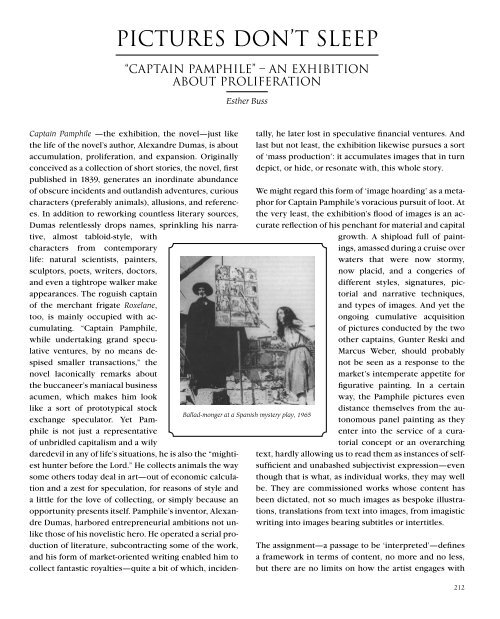EIN BILD ROMAN STÜCKEN A Pictorial Novel In Pieces - Captain ...
EIN BILD ROMAN STÜCKEN A Pictorial Novel In Pieces - Captain ...
EIN BILD ROMAN STÜCKEN A Pictorial Novel In Pieces - Captain ...
Sie wollen auch ein ePaper? Erhöhen Sie die Reichweite Ihrer Titel.
YUMPU macht aus Druck-PDFs automatisch weboptimierte ePaper, die Google liebt.
PICTURES DON’T SLEEP<br />
“<strong>Captain</strong> Pamphile” – an exhibition<br />
about proliferation<br />
<strong>Captain</strong> Pamphile —the exhibition, the novel—just like<br />
the life of the novel’s author, Alexandre Dumas, is about<br />
accumulation, proliferation, and expansion. Originally<br />
conceived as a collection of short stories, the novel, first<br />
published in 1839, generates an inordinate abundance<br />
of obscure incidents and outlandish adventures, curious<br />
characters (preferably animals), allusions, and references.<br />
<strong>In</strong> addition to reworking countless literary sources,<br />
Dumas relentlessly drops names, sprinkling his narrative,<br />
almost tabloid-style, with<br />
characters from contemporary<br />
life: natural scientists, painters,<br />
sculptors, poets, writers, doctors,<br />
and even a tightrope walker make<br />
appearances. The roguish captain<br />
of the merchant frigate Roxelane,<br />
too, is mainly occupied with accumulating.<br />
“<strong>Captain</strong> Pamphile,<br />
while undertaking grand speculative<br />
ventures, by no means despised<br />
smaller transactions,” the<br />
novel laconically remarks about<br />
the buccaneer’s maniacal business<br />
acumen, which makes him look<br />
like a sort of prototypical stock<br />
exchange speculator. Yet Pamphile<br />
is not just a representative<br />
of unbridled capitalism and a wily<br />
daredevil in any of life’s situations, he is also the “mightiest<br />
hunter before the Lord.” He collects animals the way<br />
some others today deal in art—out of economic calculation<br />
and a zest for speculation, for reasons of style and<br />
a little for the love of collecting, or simply because an<br />
opportunity presents itself. Pamphile’s inventor, Alexandre<br />
Dumas, harbored entrepreneurial ambitions not unlike<br />
those of his novelistic hero. He operated a serial production<br />
of literature, subcontracting some of the work,<br />
and his form of market-oriented writing enabled him to<br />
collect fantastic royalties—quite a bit of which, inciden-<br />
Esther Buss<br />
Ballad-monger at a Spanish mystery play, 1965<br />
tally, he later lost in speculative financial ventures. And<br />
last but not least, the exhibition likewise pursues a sort<br />
of ‘mass production’: it accumulates images that in turn<br />
depict, or hide, or resonate with, this whole story.<br />
We might regard this form of ‘image hoarding’ as a metaphor<br />
for <strong>Captain</strong> Pamphile’s voracious pursuit of loot. At<br />
the very least, the exhibition’s flood of images is an accurate<br />
reflection of his penchant for material and capital<br />
growth. A shipload full of paintings,<br />
amassed during a cruise over<br />
waters that were now stormy,<br />
now placid, and a congeries of<br />
different styles, signatures, pictorial<br />
and narrative techniques,<br />
and types of images. And yet the<br />
ongoing cumulative acquisition<br />
of pictures conducted by the two<br />
other captains, Gunter Reski and<br />
Marcus Weber, should probably<br />
not be seen as a response to the<br />
market’s intemperate appetite for<br />
figurative painting. <strong>In</strong> a certain<br />
way, the Pamphile pictures even<br />
distance themselves from the autonomous<br />
panel painting as they<br />
enter into the service of a curatorial<br />
concept or an overarching<br />
text, hardly allowing us to read them as instances of selfsufficient<br />
and unabashed subjectivist expression—even<br />
though that is what, as individual works, they may well<br />
be. They are commissioned works whose content has<br />
been dictated, not so much images as bespoke illustrations,<br />
translations from text into images, from imagistic<br />
writing into images bearing subtitles or intertitles.<br />
The assignment—a passage to be ‘interpreted’—defines<br />
a framework in terms of content, no more and no less,<br />
but there are no limits on how the artist engages with<br />
212


